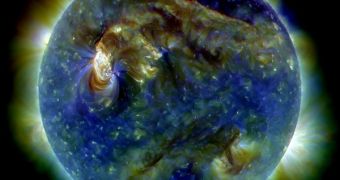Royal Holloway, University of London (RHUL) astrophysicists propose in a new study that dark matter trapped at the very core of the Sun is responsible for cooling down the star's inner furnace. This idea is bound to trigger heated debates in the international scientific community.
Dr Stephen West's team explains that the Milky Way, like most other large galaxies, must be surrounded by a halo of dark matter that augments the gravitational pull of baryonic matter within.
Given the position our solar system occupies in the galaxy, it stands to reason that the Sun and all planets orbiting it are moving through clouds of dark matter. While they spin relatively slow, our solar system rushes through, Daily Galaxy reports.
If indeed dark matter only interacts with regular matter through gravity, then it could be that the Sun's intense pull is drawing the stuff in, concealing it at its very core. The RHUL team proposes that this phenomenon is having a host of consequences on the star's behavior.
The calculations experts compiled indicate that the effects of high dark matter concentrations within the Sun would be to reduce the latter's core temperature by a relatively large margin. This idea is based on the fact that dark matter has the tendency to absorb heat and dissipate it towards the stellar surface.
In such a scenario, the corona may become extremely hot, while the core may be constantly cooling, despite being powered by nuclear fusion reactions between hydrogen isotopes. This ongoing process should theoretically leave behind small indicators that could be used for verifying this idea.
“Dark matter makes up more than 80 per cent of the total mass of the Universe. We know that dark matter exists, but to date it has never been produced in a laboratory or directly observed in any experiment, as a result we have very little information about what it actually is,” West explains.
“It is important that we examine all possible ways of probing the nature of dark matter and the Sun could provide us with an unexpected laboratory in which to do this,” the expert goes on to say.
If what he and his team are proposing is correct, then the temperature shift should lead to the production of different numbers of neutrinos from what would normally be expected. By studying these small elementary particles, experts may be able to confirm or infirm the new idea.
“The next step in the work is to look more closely at the change in the predicted number of neutrinos produced in the Sun as a result of dark matter collecting at the core and to examine the sensitivity of existing neutrino experiments to this change,” the team leader adds.
“In addition, an investigation of the possibility of probing this type of dark matter at the Large Hadron Collider is planned. The LHC could provide complimentary information about the properties of dark matter which along with the information from the sun may lead to a clearer picture of one of the more puzzling issues in physics,” he concludes.

 14 DAY TRIAL //
14 DAY TRIAL //